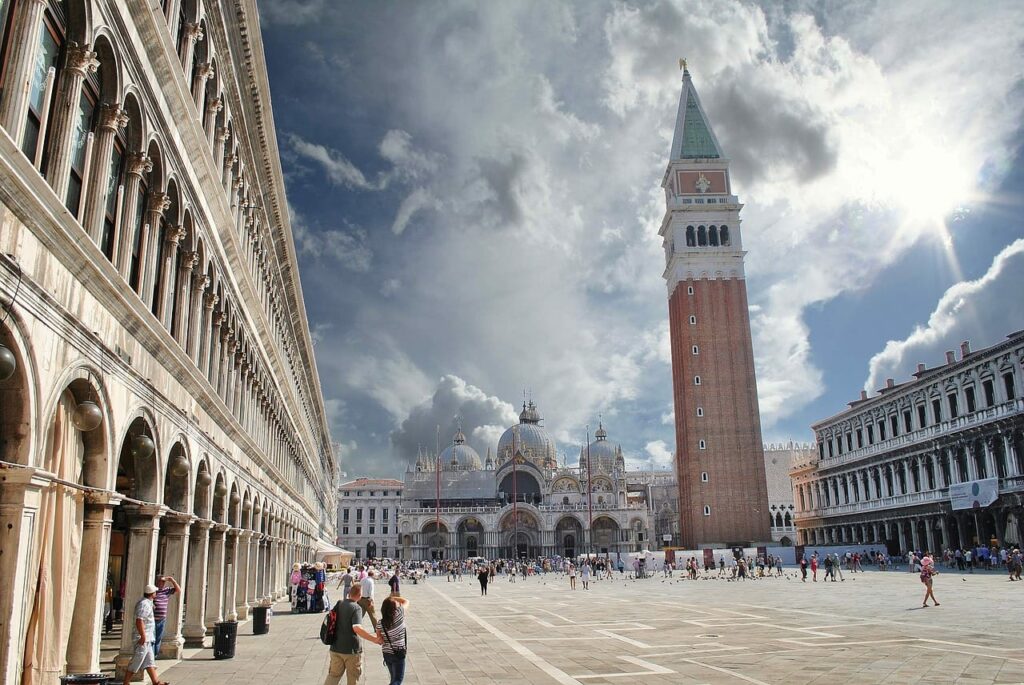Weiter erforschen
Venedig, Italien
Unverzichtbares Venedig
Mehr erforschen
Der Markusdom ist eine der meistbesuchten Sehenswürdigkeiten in Venedig und ein Muss für jeden Italien-Reisenden! Mit einer Geschichte, die bis ins 9. Jahrhundert n. Chr. zurückreicht, ist sie auch eine Kirche mit vielen interessanten Geschichten und Legenden - hier sind sechs der faszinierendsten Fakten über den Markusdom!
1 Die Basilika begann mit einer verwegenen Geschichte über eine Entführung
 Die erste Markusdom wurde im 9. Jahrhundert an dieser Stelle erbaut, um sehr heilige Reliquien aufzubewahren - Reliquien, die gestohlen worden waren! Im Jahr 828 stahlen Kaufleute aus Venedig den Leichnam des Evangelisten Markus, eines der vier Apostel, aus Alexandria, Ägypten. Die Legende besagt, dass sie sie an den (muslimischen) Wachen vorbeischmuggelten, indem sie sie unter Schichten von Schweinefleisch in Fässern versteckten!
Die erste Markusdom wurde im 9. Jahrhundert an dieser Stelle erbaut, um sehr heilige Reliquien aufzubewahren - Reliquien, die gestohlen worden waren! Im Jahr 828 stahlen Kaufleute aus Venedig den Leichnam des Evangelisten Markus, eines der vier Apostel, aus Alexandria, Ägypten. Die Legende besagt, dass sie sie an den (muslimischen) Wachen vorbeischmuggelten, indem sie sie unter Schichten von Schweinefleisch in Fässern versteckten!
Als auf See ein Sturm die Grabräuber und ihre kostbare Fracht fast ertrinken ließ, soll der Heilige Markus dem Kapitän erschienen sein und ihm befohlen haben, die Segel zu setzen. Das Schiff wurde gerettet, und die Kaufleute sagten, sie verdankten ihre Sicherheit dem Wunder.
Die gesamte Geschichte ist auf dem Mosaik aus dem 13. Jahrhundert über der linken Tür beim Betreten der Basilika dargestellt.
2 Das Mosaik reicht aus, um 1,5 amerikanische Fußballfelder zu bedecken!
There are more than 85,000 square feet (or 8,000 square meters) of mosaic in St. Mark’s Basilica… or enough mosaic to cover over 1.5 American football fields! The mosaics were done over 8 centuries, mostly in gold, and the result is astonishing. Enter the basilica at different times of day to see how the light makes the colors and scenes, look different.
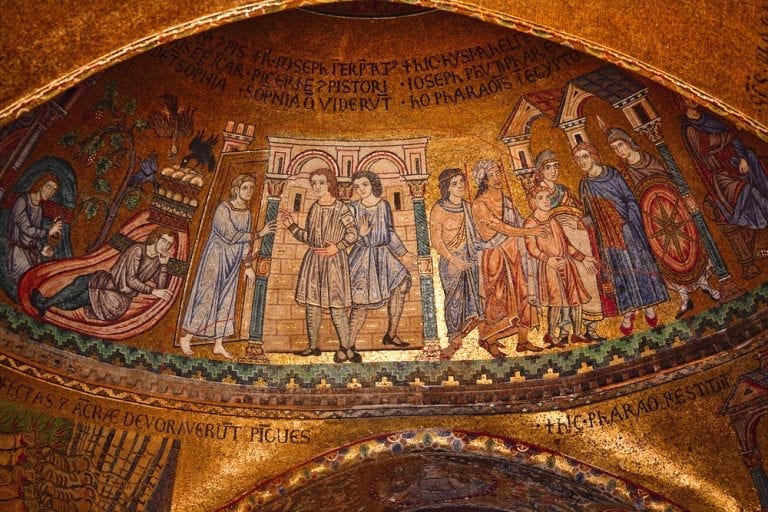

3 Es gibt mehr als 500 Spalten
Ein weiteres Beispiel für die schiere Größe und die Menge an erstaunlichen Dingen im Markusdom ist die Anzahl der Säulen. Es gibt mehr als 500 Säulen und Kapitelle in der Basilika, die meisten sind byzantinisch und stammen aus dem 6. bis 11. Einige klassische Kapitelle aus dem 3. Jahrhundert sind auch dabei!

4 Ein Großteil der Schätze der Basilika stammt aus den Kreuzzügen und aus Konstantinopel
Vor allem der vierte Kreuzzug bescherte dem Markusdom einen Glücksfall. Schließlich war dies der Kreuzzug, der 1204 mit der Eroberung von Konstantinopel (dem heutigen Istanbul) endete.
The result? A lot of treasure was shipped to Venice, and installed in St. Mark’s Basilica — including the four bronze horses, an icon of the Madonna Nicopeia, enamels of the Golden Altar-piece, relics, crosses, chalices, and patens!
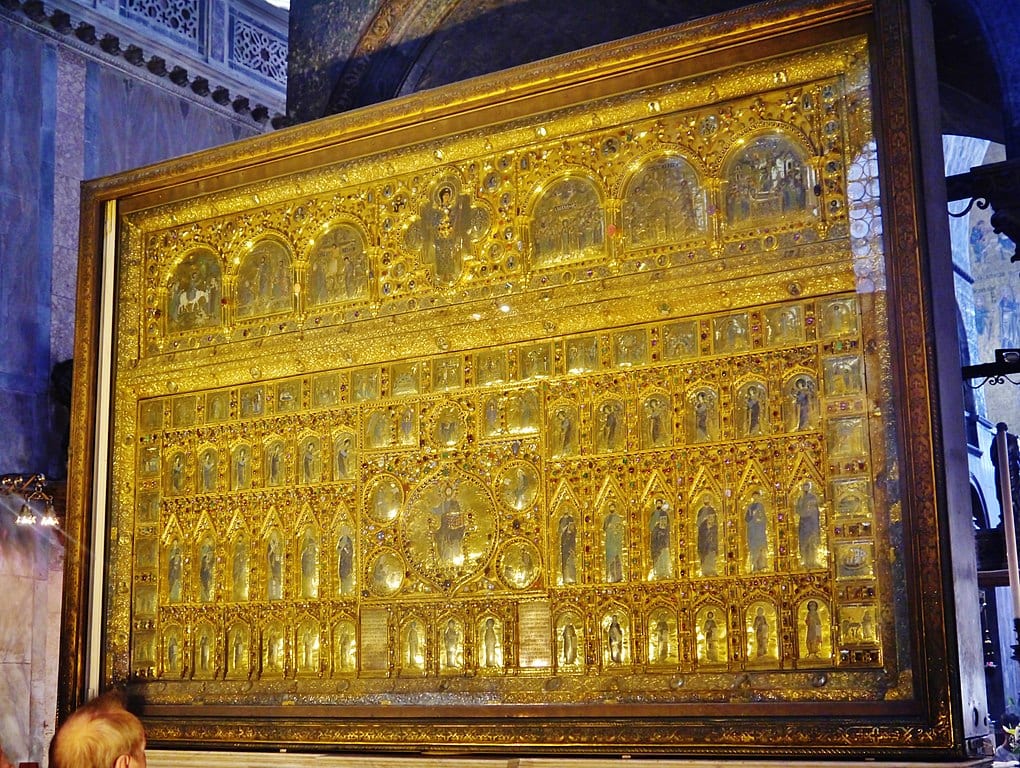
5 Der Pala d'Oro stellt die Kronjuwelen in den Schatten
Vergessen Sie die glitzernden Juwelen im Tower of London: Die königliche Familie hat nichts gegen den Markusdom! Der Pala d'Oro, ein byzantinischer Altarschirm aus Gold, ist mit Hunderten von Edelsteinen besetzt - buchstäblich. Darunter befinden sich 1.300 Perlen, 300 Smaragde, 300 Saphire, 400 Granate, 100 Amethyste sowie Rubine und Topase.
6 Dieser Glockenturm? Er stürzte einst ein
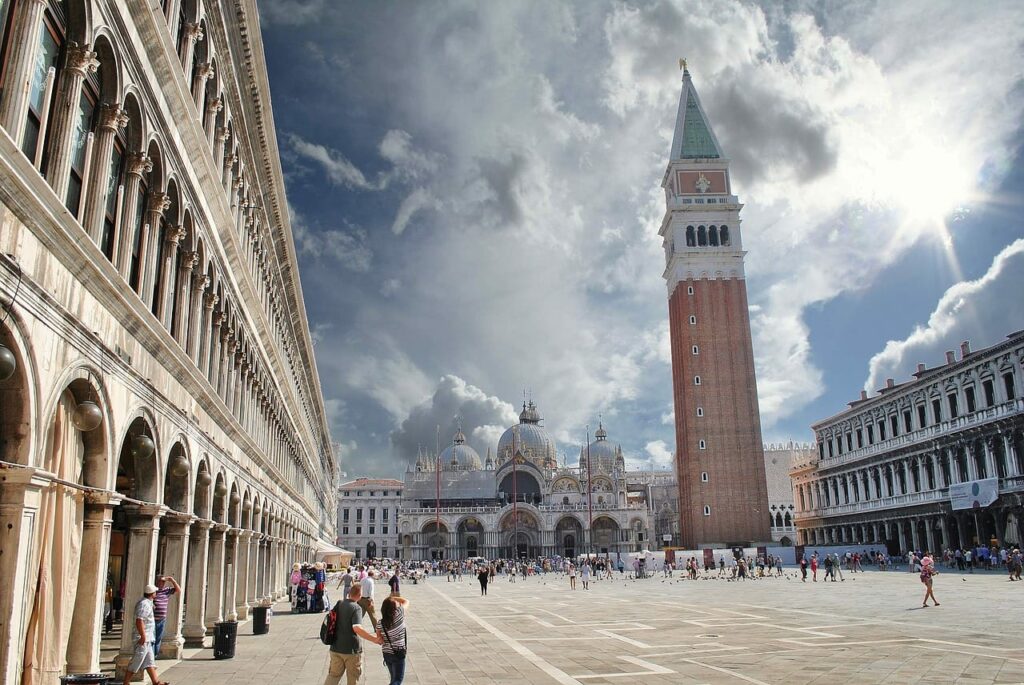
Der 98,6 Meter hohe Glockenturm des Markusdoms stammt aus dem 9. Jahrhundert, musste aber 1903 wieder aufgebaut werden. Der Grund? Er stürzte ein! Er war im 16. Jahrhundert überarbeitet worden, und das offenbar nicht besonders gut.
Sie stürzte am 14. Juli 1902 ein. (Um fair zu sein, hatte sie zuvor mehrere Erdbeben überstanden!) Obwohl der Einsturz den Balkon der Basilika unter den Trümmern begrub, konnte die Kirche selbst glücklicherweise gerettet werden. Aber der Vorfall war peinlich genug!
Von 1903 bis 1912 wurde der Glockenturm genau so wiederaufgebaut, wie er einmal war - nur mit besseren und sichereren Techniken.
Ok, wir haben sechs erwähnt, aber da wir gerade dabei sind, hier weitere faszinierende Einblicke:
- Die Goldstücke der Mosaiken im Markusdom sind aus ECHTEM Gold!
Venice was in the past a very wealthy city of merchants: what the Republic lacked in military strength or in land domination, it had in riches. The basilica’s mosaics are not just a way to please God and St. Mark or to communicate complex religious concepts, they were also a way to show the wealth of the city to important guests, like kings or ambassadors from other countries.
Die goldenen Stücke sind tatsächlich aus Gold: Jedes Stück besteht aus einem dünnen Blattgold, das zwischen zwei Schichten aus klarem Glas "eingeklemmt" ist. Mit einer solchen Zurschaustellung von kostbarem Material konnten die Venezianer gleichzeitig ihre große Hingabe, aber auch ihr politisches "Gewicht" zeigen: eine äußerst wichtige Sache für ein so kleines Land.
- Die großen äußeren Kuppeln über der Basilika sind in Wirklichkeit unecht!
In Venice, it’s impossible to build huge structures: the terrain is frail, so you have to carefully stick to small, light and flexible buildings. But the Venetians had to find a way to astonish their guests: so they optimized some very clever tricks to cheat the eye and give everyone the impression that the buildings are huge and imposing.
In St. Mark’s Basilica, there is a great example of this: the five big domes that give the building its distinctive shape are just a superstructure made of wood covered with a thin layer of lead. They are actually completely empty: the brick-built domes with the mosaics that you see inside the church are much lower.
We can arguably say that the only role of those big empty domes is to make the building look much bigger than it really is: this way the ships approaching the city could recognize its shape from afar, and be even more astonished by the legendary city rising from the waters.
- Im Jahr 2019 überschwemmte eine große "acqua alta" die Kirche vollständig!
In the Venetian Lagoon, there are tides: sometimes these tides go higher than normal and as a result, some parts of the city get flooded. St. Mark’s Square is the lowest part of the city, so it’s pretty common to see its floor partially or totally submerged in water.
But on November 12, 2019, things went completely out of control: the tide rose so high that it reached the second-highest level ever recorded in the history of the city. The custodians of the church were unprepared for this event: the water not only flooded the antechamber of the basilica, which is at the same level as the square but also the church itself, which is much higher.
The damage was substantial and the building is still recovering: at least this tragic event gave a big push to the completion of the MOSE project, a system of mobile barriers meant to protect the Lagoon from the most dangerous tides. The barriers were tested a couple of times in 2020 and apparently, they worked fine: we all hope they will be able to protect the basilica in the future.
- Der Markusdom ist weder die älteste noch die größte Kirche in Venedig!
The St. Mark’s Basilica was built starting from the IX century: but the history of Venice starts way before that moment, in the V-VI century. So there are churches around the city that predate the most important monument: according to historians, the oldest holy building of the city could be the church of San Giacometto, very close to the Rialto bridge. The Rialto area was, in fact, the first spot that was colonized when the islands started to be populated: the city of Venice was actually called “Rialto” for the first centuries.
Despite its enormous size, at least in proportion with the other buildings of the city, St. Mark’s Basilica is also not the biggest church: this title goes to the church of Santi Giovanni e Paolo, home to the very powerful Dominican monastic order. Their monastery was so big that when Napoleon conquered Venice he chose that building to become the first big public hospital in the city: and the hospital is there still today! You can learn more about San Giacometto and Santi Giovanni e Paolo if you take the Welcome to Venice tour or the Venice in a Day tour, which both feature these very important churches!
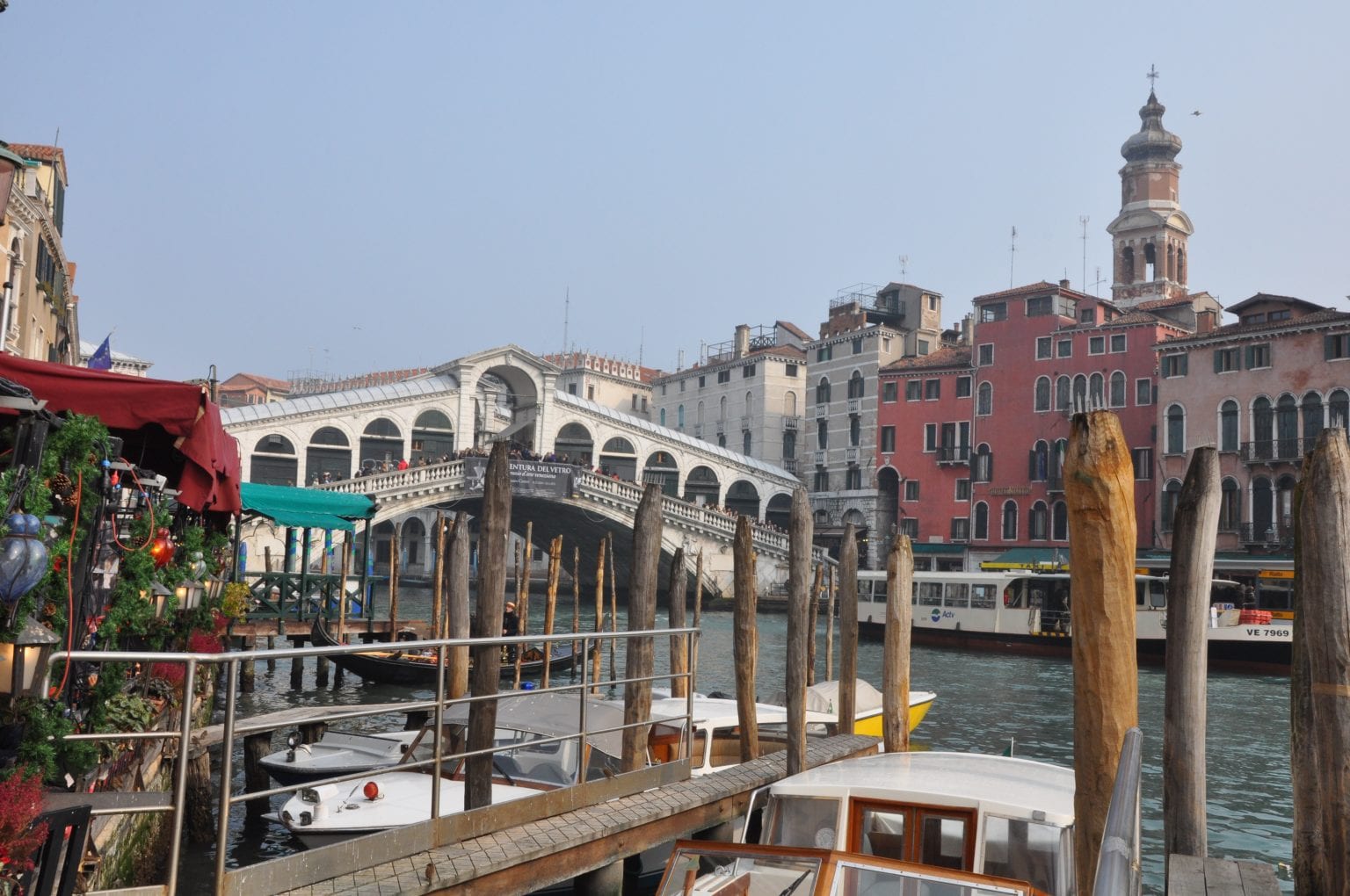
Special thanks go to our Walks of Italy guide Mosè Viero for sharing these additional interesting facts about St. Mark’s Basilica.
Wenn Sie mehr erfahren möchten, Schauen Sie sich unsere Erfahrungen in Venedig mit dem Markusdom und dem Dogenpalast an - oder, für einen echten VIP-Besuch, betreten Sie den Markusdom nach der Öffnungszeit, wenn er für die Öffentlichkeit geschlossen ist!
Weiter erforschen
Venedig, Italien
Unverzichtbares Venedig
Mehr erforschen

